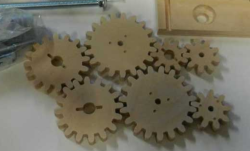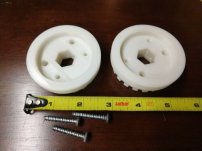I use Smooth-On products for all my liquids, mostly for effects.
but they have some awesome industrial usages also, I have seen gears.
call them and they can tell you best scenario.
Smooth-On
I would injection mold them, but then again I do tooling so the mold would be free for me, other than materials.
Dupont Zytel/Hytrel Nylon 66 with 30% glass.
gears molded
EDIT:
And to answer the OP's actual question:
"I want to have them made from
machined acetal or nylon, or injection molded from suitable material. All things being equal,
which material and production method would be better, how should they be made, and
how thick should they be to be comparable in strength to the plywood, or assure no failures?"
Injection molding is cheapest of the two in the long run, especially if your doing a lot of parts. Machining is the most expensive, but cheaper if your only doing a set amount of a small quantity over all.
Machining is more accurate than injection molding them, but its high accuracy is lost in this assembly context.
Material would be Nylon or Acetal, I have made a few gears from both, but mostly Nylon, even for extreme speeds and uses like a blender.
Injection molding the parts I would probably not leave them solid, but would thin them out in the center to save on plastic cost, reduce cycle times, reduce sinking and warping, molding needs uniform wall thickness.
Injection molding them as far as design, and getting it implemented is the most involved though. Unless you pay someone else to design and machine the mold and a molder to run it.
2 cents.



 .
.